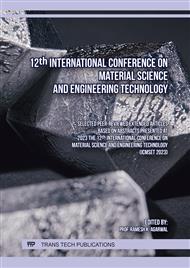p.63
p.69
p.79
p.85
p.95
p.103
p.109
p.115
p.123
Study of Abaca/Carbon/Epoxy Hybrid Composite Properties as an Alternative Prosthetic Socket Material
Abstract:
Composites of natural fiber-reinforced thermoplastic and thermoset polymers have been studied for developing prosthetic socket materials. This study investigated the abaca fiber (AF)/carbon fiber (CF)/epoxy (EP) hybrid composite properties: i.e., tensile, flexural, impact, thermal, and water absorption, by varying AF and CF ratios of 1: 0, 0: 1, 2: 1, 3: 1, and 4: 1 with 80 vol% epoxy resin. The cracks formed in bending test specimens were characterized with an optical microscope, whereas the tensile fracture surface was characterized by scanning electron microscopy (SEM). The results confirmed that the mechanical properties of the CF/EP composite are the highest. The higher the AF/CF ratio, the lower the hybrid composite's mechanical properties and the higher the water absorption. The hybrid composite with a 2:1 AF/CF ratio achieved the highest tensile and flexural strengths of 70 MPa and 103 MPa, respectively, and the lowest water absorption of 7.89%. Based on the experimental results, a simulation of the prosthetic socket was performed using Autodesk Inventor 2019 integrated with ANSYS Workbench 2019 R1, resulting in von Mises stress of 2.14 MPa and deformation of 0.015 mm. Besides, its thermal gravimetric analysis (TGA) resulted in good thermal stability.
Info:
Periodical:
Pages:
95-102
Citation:
Online since:
March 2024
Keywords:
Price:
Сopyright:
© 2024 Trans Tech Publications Ltd. All Rights Reserved
Share:
Citation:



